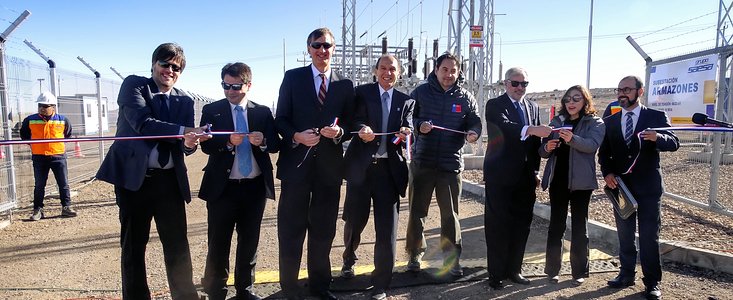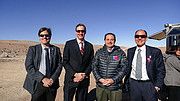Annuncio
Il ministro dell’Energia cileno assiste al collegamento del Paranal alla rete elettrica
04 Agosto 2017
Il ministro dell’Energia cileno, Andrés Rebolledo, di recente ha partecipato alla cerimonia di inaugurazione della connessione dei siti dell’ESO Paranal e Armazones, quest’ultimo sede del futuro ELT (Extremely Large Telescope), alla rete di energia elettrica nazionale cilena. La nuova fornitura elettrica ridurrà sia i costi sia l’impronta di CO2 dell’osservatorio.
Il ministro Rebolledo ha sottolineato l’importanza di questo progresso come esempio dell’efficienza della rete elettrica cilena e della sua capacità di fornire energia sicura e di alta qualità per la ricerca astronomica d’avanguardia.
Il responsabile di programma dell'ELT Roberto Tamai, che ha ricoperto il ruolo di project manager per questa modernizzazione dell'ESO, ha ringraziato il governo e le istituzioni cileni per il loro aiuto nella creazione dell'infrastruttura energetica che sosterrà i progressi nel sito dell’ELT. Con il suo specchio primario da 39 metri, la costruzione dell’ELT è una grandissima sfida tecnologica e ingegneristica. Tamai ha sottolineato che la fornitura di energia elettrica rappresenta un punto chiave dell’infrastruttura che ci permetterà di rispondere ad alcune domande fondamentali: da dove veniamo? Dove andiamo? Siamo soli nell’Universo?
La connessione dei siti Paranal e Armazones alla rete elettrica cilena è stata possibile grazie al Gruppo SAESA, la società che ora è responsabile della fornitura di energia permanente e sostenibile all’Osservatorio del Paranal e al sito dell’ELT. Dato che il sito è così lontano, a 130 km da Antofagasta in mezzo al Deserto di Atacama, il progetto ha rappresentato una sfida importante, ma è stato completato con successo grazie agli sforzi di più di 300 operai. Il risultato include un sistema di trasmissione da 66 kilovolt, lungo 50 km, con due nuove sottostazioni: una a Paposo (330/66 kV), chiamata la sottostazione del Paranal, e l’altra tra il Paranal e l’Armazones (66/23 kV), chiamata la sottostazione dell’Armazones.
Questa connessione ridurrà anche l’impatto ambientale dei siti Paranal e Armazones, dato che non saranno più usati combustibili fossili nei generatori per creare energia. Nel suo discorso, Roberto Tamai ha sottolineato che l’espansione della rete elettrica ha portato l’ulteriore beneficio di poter sfruttare l’abbondante luce solare per produrre energia pulita che sarà introdotta nel sistema elettrico nazionale.
L’ELT userà l’Universo come massimo laboratorio scientifico, effettuando osservazioni attualmente impossibili per qualsiasi telescopio da terra, per rispondere ad alcune delle più complesse domande astronomiche dei nostri tempi. L’ELT dovrebbe vedere la prima luce nel 2024.
Ulteriori informazioni
L'ESO (European Southern Observatory, o Osservatorio Australe Europeo) è la principale organizzazione intergovernativa di Astronomia in Europa e l'osservatorio astronomico più produttivo al mondo. È sostenuto da 16 paesi: Austria, Belgio, Brasile, Danimarca, Finlandia, Francia, Germania, Italia, Paesi Bassi, Polonia, Portogallo, Regno Unito, Repubblica Ceca, Spagna, Svezia, e Svizzera, oltre al paese che ospita l'ESO, il Cile. L'ESO svolge un ambizioso programma che si concentra sulla progettazione, costruzione e gestione di potenti strumenti astronomici da terra che consentano agli astronomi di realizzare importanti scoperte scientifiche. L'ESO ha anche un ruolo di punta nel promuovere e organizzare la cooperazione nella ricerca astronomica. L'ESO gestisce tre siti osservativi unici al mondo in Cile: La Silla, Paranal e Chajnantor. Sul Paranal, l'ESO gestisce il Very Large Telescope, il suo avanzato interferometro e due telescopi per survey, VISTA, che lavora nella banda infrarossa, e il VST (VLT Survey Telescope), che lavora in luce visibile. L'ESO è anche il partner principale di due strutture sul Chajnantor, APEX e ALMA, il più grande progetto astronomico esistente. E sul Cerro Armazones, vicino al Paranal, l'ESO sta costruendo l'Extremely Large Telescope o ELT (significa Telescopio Estremamente Grande), un telescopio da 39 metri che diventerà "il più grande occhio del mondo rivolto al cielo".
Links
- Mappa che mostra le connessioni della rete con i siti Paranal e Armazones
- Informazioni sull’ESO “verde”
- Scopri di più sull’ELT sul sito web dell’ESO
- Ultime notizie e comunicati stampa sull’ELT
- Pagina delle FAQ sull’ELT
- Immagini e video dell’ELT
- Discorso di Roberto Tamai (solo in spagnolo)
Contatti
Richard Hook
ESO Public Information Officer
Garching bei München, Germany
Tel: +49 89 3200 6655
Email: rhook@eso.org
Riguardo all'annuncio
| Identificazione: | ann17049 |
Our use of Cookies
We use cookies that are essential for accessing our websites and using our services. We also use cookies to analyse, measure and improve our websites’ performance, to enable content sharing via social media and to display media content hosted on third-party platforms.
ESO Cookies Policy
The European Organisation for Astronomical Research in the Southern Hemisphere (ESO) is the pre-eminent intergovernmental science and technology organisation in astronomy. It carries out an ambitious programme focused on the design, construction and operation of powerful ground-based observing facilities for astronomy.
This Cookies Policy is intended to provide clarity by outlining the cookies used on the ESO public websites, their functions, the options you have for controlling them, and the ways you can contact us for additional details.
What are cookies?
Cookies are small pieces of data stored on your device by websites you visit. They serve various purposes, such as remembering login credentials and preferences and enhance your browsing experience.
Categories of cookies we use
Essential cookies (always active): These cookies are strictly necessary for the proper functioning of our website. Without these cookies, the website cannot operate correctly, and certain services, such as logging in or accessing secure areas, may not be available; because they are essential for the website’s operation, they cannot be disabled.
Functional Cookies: These cookies enhance your browsing experience by enabling additional features and personalization, such as remembering your preferences and settings. While not strictly necessary for the website to function, they improve usability and convenience; these cookies are only placed if you provide your consent.
Analytics cookies: These cookies collect information about how visitors interact with our website, such as which pages are visited most often and how users navigate the site. This data helps us improve website performance, optimize content, and enhance the user experience; these cookies are only placed if you provide your consent. We use the following analytics cookies.
Matomo Cookies:
This website uses Matomo (formerly Piwik), an open source software which enables the statistical analysis of website visits. Matomo uses cookies (text files) which are saved on your computer and which allow us to analyze how you use our website. The website user information generated by the cookies will only be saved on the servers of our IT Department. We use this information to analyze www.eso.org visits and to prepare reports on website activities. These data will not be disclosed to third parties.
On behalf of ESO, Matomo will use this information for the purpose of evaluating your use of the website, compiling reports on website activity and providing other services relating to website activity and internet usage.
Matomo cookies settings:
Additional Third-party cookies on ESO websites: some of our pages display content from external providers, e.g. YouTube.
Such third-party services are outside of ESO control and may, at any time, change their terms of service, use of cookies, etc.
YouTube: Some videos on the ESO website are embedded from ESO’s official YouTube channel. We have enabled YouTube’s privacy-enhanced mode, meaning that no cookies are set unless the user actively clicks on the video to play it. Additionally, in this mode, YouTube does not store any personally identifiable cookie data for embedded video playbacks. For more details, please refer to YouTube’s embedding videos information page.
Cookies can also be classified based on the following elements.
Regarding the domain, there are:
- First-party cookies, set by the website you are currently visiting. They are stored by the same domain that you are browsing and are used to enhance your experience on that site;
- Third-party cookies, set by a domain other than the one you are currently visiting.
As for their duration, cookies can be:
- Browser-session cookies, which are deleted when the user closes the browser;
- Stored cookies, which stay on the user's device for a predetermined period of time.
How to manage cookies
Cookie settings: You can modify your cookie choices for the ESO webpages at any time by clicking on the link Cookie settings at the bottom of any page.
In your browser: If you wish to delete cookies or instruct your browser to delete or block cookies by default, please visit the help pages of your browser:
Please be aware that if you delete or decline cookies, certain functionalities of our website may be not be available and your browsing experience may be affected.
You can set most browsers to prevent any cookies being placed on your device, but you may then have to manually adjust some preferences every time you visit a site/page. And some services and functionalities may not work properly at all (e.g. profile logging-in, shop check out).
Updates to the ESO Cookies Policy
The ESO Cookies Policy may be subject to future updates, which will be made available on this page.
Additional information
For any queries related to cookies, please contact: pdprATesoDOTorg.
As ESO public webpages are managed by our Department of Communication, your questions will be dealt with the support of the said Department.


